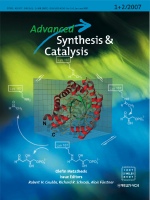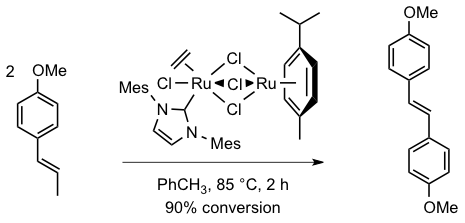"Homobimetallic Ruthenium-N-Heterocyclic Carbene Complexes: Synthesis, Characterization, and Catalytic Applications"
Xavier Sauvage, Yannick Borguet, Alfred F. Noels, Lionel Delaude, and Albert Demonceau
 |
source: Advanced Synthesis & Catalysis
year: 2007
volume: 349
first page: 255
last page: 265
doi: 10.1002/adsc.200600515
|

Abstract: Two new homobimetallic ruthenium-arene complexes [(p-cymene)Ru(μ-Cl)3RuCl(η2-C2H4)(L)], where L = 1,3-bis(2,4,6-trimethylphenyl)imidazol-2-ylidene (3a) or 1,3-bis(2,4,6-trimethylphenyl)-4,5-dichloroimidazol-2-ylidene (3b), were isolated in high yields upon heating a toluene solution of [RuCl2(p-cymene)]2 with 1 equivalent of carbene ligand under an ethylene atmosphere. They were characterized by NMR and TGA. Their catalytic activity was investigated in the atom transfer radical polymerization of vinyl monomers. In the polymerization of methyl methacrylate, complex 3a displayed faster reaction rates than 3b and the related phosphine-based complex 2a (L = tricyclohexylphosphine), although control was more effective with the latter catalyst. When n-butyl acrylate or styrene served as monomers, a major shift of reactivity was observed between complex 2a that promoted controlled radical polymerization, and complexes 3a or 3b that favored metathetical coupling. Further homocoupling experiments with various styrene derivatives confirmed the outstanding aptitude of complex 3a (and to a lesser extent of 3b) to catalyze olefin metathesis reactions. Contrary to monometallic ruthenium-arene complexes of the [RuCl2(p-cymene)(L)] type, the new homobimetallic species did not require the addition of a diazo compound nor visible light illumination to initiate the ring-opening metathesis of norbornene or cyclooctene. When α,ω-dienes were exposed to 3a or 3b, a mixture of cycloisomerization and ring-closing metathesis products was obtained in a non-selective way. Addition of a terminal alkyne co-catalyst enhanced the metathetical activity while completely repressing the cycloisomerization process. Thus, quantitative conversions of diethyl 2,2-diallylmalonate and N,N-diallyltosylamide were achieved within 2 h at room temperature using 2 mol-% of catalyst precursor 3a and 6 mol-% of phenylacetylene.
Keywords: Arene Ligands, Homogeneous Catalysis, Metathesis, Polymerization, Radical Reactions, Ruthenium
[Full Text] [<< Previous Article] [Back to the List of Publications] [Next Article >>] l.delaude@ulg.ac.be